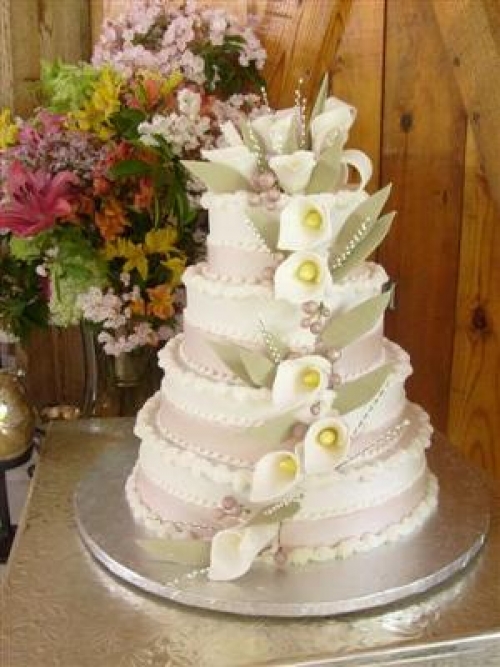La torta matrimoniale ha le sue origini andando indietro ai tempi degli antichi Romani. Cosi ne parlano la storia e le antiche legende. Poi con il passare degli anni questa tradizione matrimoniale attraverso il confine spargendosi in tutta Europa. Si cambiò la forma e le ricette ma il simbolismo rimase lo stesso. Il rito di tagliare la torta era un modo di assicurare agli sposi di avere una vita prospera e fertile con una promessa di una eterna unione tra gli sposi.
Wouldn't you just know it?
It was the Romans who began it all, according to history's myths and legends. In those days, to start things off in the right direction and to seal the marriage, the groom broke a loaf of bread over his bride's head, symbolizing his dominance and the promise of prosperity and fertility in the newly created relationship.
Initially wheat bread was used for this nupital purpose and then barley bread took the lead. Actually, slight differences in regional influences dictated the ingredients but eventually the bread evolved into the barley cake.
The guests had to settle for the crumbs, but this also was a symbol of ensuring fertility and betrothal for those unmarried women who managed to consume a few. This custom lead to the tradition of serving a piece of cake to the guests, probably so there wouldn't be a mad scramble for the crumbs-knocking things over and such.
This in turn led to the size of the cake becoming larger in order to accommodate the growing number of guests, and others, who wanted fertility and prosperity. I suppose some simply wanted a piece of cake.
As the Romans moved about Europe they took their wedding customs along to share with others. The cake took on various forms and recipes, and the symbolisms evolved, but most nearly kept the same themes: breaking of the cake, like breaking of the bread, ensured a prosperous life, while serving a piece of cake, or crumbs, to the guests also promised their future prosperity.
At the time of the middle ages, there doesn't appear to have been any particular recipe for the wedding 'cake' which, from time to time and place to place became fashionable to be presented by the guests. Their presents could be anything from breads and buns to biscuits or scones and, of course, cakes.
Sometimes the buns were made into a pile, over which the bride and groom sealed their marriage with a kiss. In other places guests would drop (lightly) bread on the bride's head signifying fertility and children. The guests were still served a piece to take with them, and some put it under their pillow to sleep on in order the dream of a spouse.
England took the lead in finally beginning to describe a particular composition, later recipes, for wedding cakes. There, 'cake' was unsweetened bread made with flour. Again, the cake evolved into a pie at times and in some locations, but the purpose always remained the same: prosperity and fertility, many children, and the promise of eternal partnership with your spouse.
Definite recipes with established ingredients boosted the popularity of wedding cakes late in the nineteenth century. The cake was a simple design, sometimes with a fruit baked into it. With cake becoming dominant, pies eventually phased out of the scene except in the less affluent party. Even there, the cake eventually won out.
In the Victorian age, as a symbol of affluence, very white icing required very refined sugar, a very expensive commodity then. Initially, this was not a symbol of the bride's purity but of the cake's expensive ingredients. You can see how the cake's color, and eventually its size, became a recognized sign of the well-to-do and well-mannered family. Eventually the cakes came to be referred to as the bride's cake, and for this reason became a symbol of her purity. Nonetheless, it remained for a good while a very visible symbol of family status.
In the United States the tradition of having a groom's cake along with the bride's cake has survived mainly in the Old South. Its color is usually a darker color to contrast with the white of the bride's cake. Its purpose has been lost or at least misplaced. No one seems to remember exactly why it was introduced.
The royals of England, and elsewhere, were the first to receive wedding cakes of multiple levels, even if the upper levels were only lightweight spun sugar. Chefs and bakers were put to the test to develop recipes and ingredients to make the upper layers lighter and the lower levels stronger. Included with this Herculean effort was the development of the decorative pillar as a true support vehicle.
Today's typical wedding cake is the descendant of the cakes of the royal families and their affluence. This image asserts a particular 'royalty' to the very special day belonging to two very special people who have promised their own private affluence to each other in a public setting-just as the early Romans had done. Gotta love those Romans!
Under the umbrella of La Casa Graziani, my father (Amleto) and mom (Dolly) were the owners and principal proprietors of Wedding Artistry in Pensacola, Florida, from the mid 1950's until the early 1990's. At first specializing in photos, they gradually added cakes and catering, imported gowns from Italy, then added flowers and jewelry. Although the business is no longer operating, I fondly remember its heyday and all I learned from being independent as we made our way in America.



